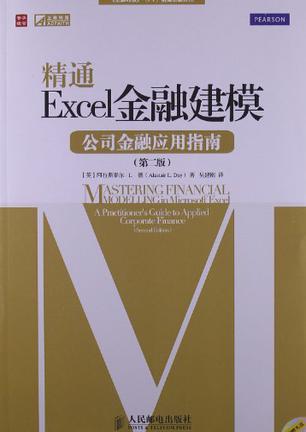-

Monte Carlo Methods in Finance
An invaluable resource for quantitative analysts who need to run models that assist in option pricing and risk management. This concise, practical hands on guide to Monte Carlo simulation introduces standard and advanced methods to the increasing complexity of derivatives portfolios. Ranging from pricing more complex derivatives, such as American and Asian options, to measuring Value at Risk, or modelling complex market dynamics, simulation is the only method general enough to capture the complexity and Monte Carlo simulation is the best pricing and risk management method available. The book is packed with numerous examples using real world data and is supplied with a CD to aid in the use of the examples. -

教鸟儿飞行
内容简介 l 金融市场是否确实可以用数学模型来解释?全球顶级金融专家特里亚纳用一长串强有力的证据证明了市场不能够被各种等式所驯服。因为那些标新立异、不合法规的人类行为支配着市场,出乎意料且难以想象的骇人事件则塑造了市场,所以使用历史数据来指导未来市场的方式并不可靠。 l 获得诺贝尔经济学奖的布莱克-斯科尔斯-默顿(BSM)模型无视黑天鹅事件的可能,无法预料到危险的产生,是造成金融灾难的罪魁祸首,我们还要继续迷信它们吗?鼓吹量化金融市场的学者们在象牙塔内坐井观天,以看似合理的数学公式对衍生产品交易员们的选择指手画脚,这些脱离了实践的理论有何资格获得实践者的信任? l 市场不需要教授,市场需要“胖东尼”——重视实效、不受理论与教条奴役的金融业内人士。特里亚纳强烈呼吁用常识性方法取代基于数学的决策模型,并且呼吁让那些有实战经验而不是仅仅拥有学术理论的人们行使金融权利。 l 适合金融界人士、管理人员与投资者。 编辑推荐 l 畅销书《黑天鹅》、《反脆弱》作者纳西姆·塔勒布最为推崇的作品。他认为帕布罗· 特里亚纳是以一种清晰的思路、可嘉的勇气和无私奉献的精神为真相服务的。这本书非常难得,它揭露了模型的副作用及其带来的危害,并无所畏惧地指出我们应该前进的方向。这本书会让读者变得更加聪明,也会使我们的世界变得更加美好、更加安全并且更具风险意识。 l 从1987年的股市“黑色星期一”到美国长期资本管理公司的危机,特里亚纳用丰富的事例和强有力的论述抨击了金融市场中对量化模型的盲目追捧。“模型对,市场错”的信条无疑本末倒置,他强调,数学公式不可能归纳、预言和掌控市场的脉动。 l 本书对近几年来困扰模型的问题以及获得大量资金支持的定量技术所存在的问题进行了一次全面的解读。要是银行家们几年前就能留意这些信息,那么,今天我们也就不必面临那么多的混乱了。 l 湛庐文化出品 -

精通Excel金融建模
《精通Excel金融建模:公司金融应用指南(第2版)》作者根据自己近20年的建模经验,为读者介绍了如何方便地利用微软的Excel建立用途各异的金融分析模型。书中内容分为两部分。第一部分介绍了开发金融模型的一般流程、模型特性及技术要求和基础模型。第二部分则具体介绍了绩效分析模型、现金流模型、预测模型、差异分析模型、盈亏平衡点分析模型、投资组合分析模型、资本成本模型、债券模型、投资分析和风险分析模型、折旧模型、租赁模型、公司价值评估模型、最优化模型,以及决策树模型、风险管理模型和数据函数与数据分析模型。 《精通Excel金融建模:公司金融应用指南(第2版)》不仅能为高等院校金融、财会、投资等专业的师生提供极具价值的专业核心技能训练指导,同样能为相关领域的从业人员提供切实的帮助。 海报: -

Optimization Methods in Finance
Optimization models play an increasingly important role in financial decisions. This is the first textbook devoted to explaining how recent advances in optimization models, methods and software can be applied to solve problems in computational finance more efficiently and accurately. Chapters discussing the theory and efficient solution methods for all major classes of optimization problems alternate with chapters illustrating their use in modeling problems of mathematical finance. The reader is guided through topics such as volatility estimation, portfolio optimization problems and constructing an index fund, using techniques such as nonlinear optimization models, quadratic programming formulations and integer programming models respectively. The book is based on Master's courses in financial engineering and comes with worked examples, exercises and case studies. It will be welcomed by applied mathematicians, operational researchers and others who work in mathematical and computational finance and who are seeking a text for self-learning or for use with courses. -

金融计算教程
金融计算教程:MATLAB金融工具箱的应用,ISBN:9787302157885,作者:张树德 编著 -

Market Risk Analysis
Written by leading market risk academic, Professor Carol Alexander, Quantitative Methods in Finance forms part one of the Market Risk Analysis four volume set. Starting from the basics, this book helps readers to take the first step towards becoming a properly qualified financial risk manager and asset manager, roles that are currently in huge demand. Accessible to intelligent readers with a moderate understanding of mathematics at high school level or to anyone with a university degree in mathematics, physics or engineering, no prior knowledge of finance is necessary. Instead the emphasis is on understanding ideas rather than on mathematical rigour, meaning that this book offers a fast-track introduction to financial analysis for readers with some quantitative background, highlighting those areas of mathematics that are particularly relevant to solving problems in financial risk management and asset management. Unique to this book is a focus on both continuous and discrete time finance so that Quantitative Methods in Finance is not only about the application of mathematics to finance; it also explains, in very pedagogical terms, how the continuous time and discrete time finance disciplines meet, providing a comprehensive, highly accessible guide which will provide readers with the tools to start applying their knowledge immediately. All together, the Market Risk Analysis four volume set illustrates virtually every concept or formula with a practical, numerical example or a longer, empirical case study. Across all four volumes there are approximately 300 numerical and empirical examples, 400 graphs and figures and 30 case studies many of which are contained in interactive Excel spreadsheets available from the accompanying CD-ROM . Empirical examples and case studies specific to this volume include: Principal component analysis of European equity indices; Calibration of Student t distribution by maximum likelihood; Orthogonal regression and estimation of equity factor models; Simulations of geometric Brownian motion, and of correlated Student t variables; Pricing European and American options with binomial trees, and European options with the Black-Scholes-Merton formula; Cubic spline fitting of yields curves and implied volatilities; Solution of Markowitz problem with no short sales and other constraints; Calculation of risk adjusted performance metrics including generalised Sharpe ratio, omega and kappa indices.